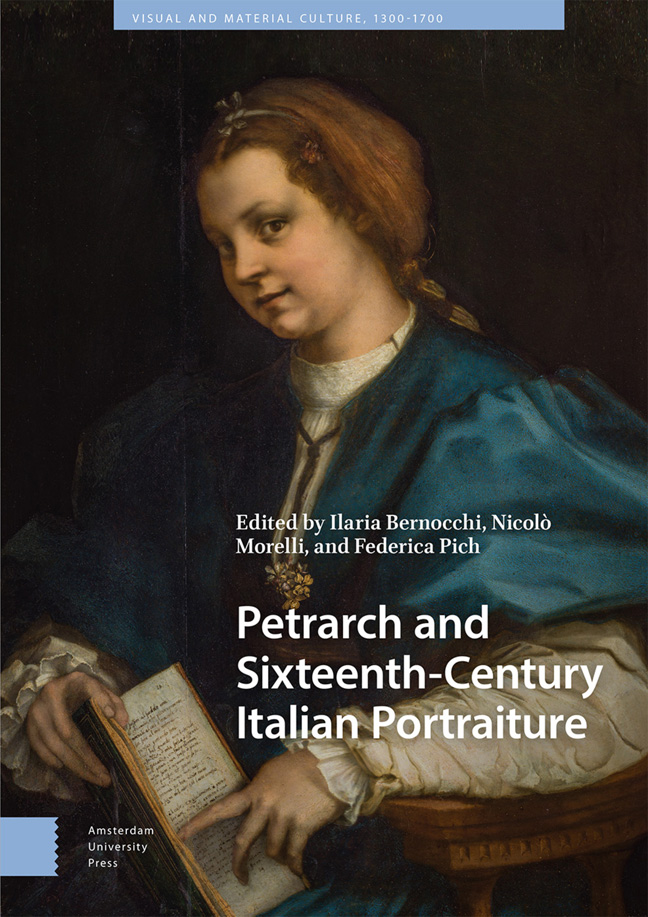Book contents
- Frontmatter
- Contents
- List of Illustrations
- Acknowledgements
- 1 Introduction
- 2 Widows, Poetry, and Portraits: Livia Spinola and Francesca Turina on the Portraits of their Dead Husbands
- 3 In Medusa's Eyes: Petrification and Marble Portraits in Late Sixteenth-Century Poetry
- 4 The Portrait of the Ideal Woman: Petrarch in Conduct Literature Texts for and about Women
- 5 Anti-Petrarchist Portraiture or a Different Petrarchist Portraiture?: A Literary Outlook on Some Non-Idealised Female Sitters in Renaissance Art
- 6 The Shadow of Petrarch: Benedetto Varchi and Agnolo Bronzino on Portraiture
- 7 Double Portraits of Petrarch and Laura in Print (c. 1544–1600)
- 8 Sonnet ‘Diptychs’ and Double Portraits: Figurative Allusions in Sixteenth-Century Encomiastic Poetry
- 9 Images of Women from Subject to Frame in Printed Portrait Books
- Bibliography
- Index
3 - In Medusa's Eyes: Petrification and Marble Portraits in Late Sixteenth-Century Poetry
Published online by Cambridge University Press: 22 February 2024
- Frontmatter
- Contents
- List of Illustrations
- Acknowledgements
- 1 Introduction
- 2 Widows, Poetry, and Portraits: Livia Spinola and Francesca Turina on the Portraits of their Dead Husbands
- 3 In Medusa's Eyes: Petrification and Marble Portraits in Late Sixteenth-Century Poetry
- 4 The Portrait of the Ideal Woman: Petrarch in Conduct Literature Texts for and about Women
- 5 Anti-Petrarchist Portraiture or a Different Petrarchist Portraiture?: A Literary Outlook on Some Non-Idealised Female Sitters in Renaissance Art
- 6 The Shadow of Petrarch: Benedetto Varchi and Agnolo Bronzino on Portraiture
- 7 Double Portraits of Petrarch and Laura in Print (c. 1544–1600)
- 8 Sonnet ‘Diptychs’ and Double Portraits: Figurative Allusions in Sixteenth-Century Encomiastic Poetry
- 9 Images of Women from Subject to Frame in Printed Portrait Books
- Bibliography
- Index
Summary
Abstract
This essay investigates literary ‘representations’ of marble portraits in the late sixteenth century, shedding light on the evolution of a Petrarchan theme up to the Renaissance period. By reshaping the metre, the identity of the marble subject, and the stylistic construction of these texts, such literary ‘representations’ became increasingly detached from the original Petrarchan model. Over time, moreover, the predominant poetic device became that of the talking statue that retells its own story. This latter change invites questions about the uncertain boundary between art and reality, particularly in the case of sculpture, and leads to a reconsideration of the late sixteenth-century enthusiasm for (and influence of) epigrams of classical and neo-Latin imprint.
Keywords: Petrarchism, petrification, Medusa, marble portraits
In recent years, much research has been done on the theme of portraiture in literature and the visual arts, focusing primarily on the relationship between poetry and painting. Literary criticism has paid less attention—indeed, less than the poets themselves—to the intersection of poetry and sculpture. There are a number of potential approaches that could be adopted to explore this theme; the purpose of the current study, however, is to briefly outline the literary ‘representations’ of marble portraits in the late sixteenth century, in order to shed light on the evolution of a theme that was important to Petrarch and to the whole of the Renaissance, but was destined to undergo significant changes. If we limit our perspective to lyrics concerning portraits in stone, we can identify four main trends: (i) at the beginning of the sixteenth century almost all the poems dedicated to a portrait in stone are strongly influenced by Petrarch (Rvf 77–78) and describe a lover who really existed; afterwards, they are almost all madrigals dedicated to an unidentified female portrait, probably entirely fictional; (ii) towards the end of the sixteenth century, we find increasingly bizarre poems whose formal and thematic features bear no relationship to the ekphrastic description of a bust based on the Petrarchan model; (iii) as the sixteenth century progresses, the poetic point of view shifts from being solely that of the poet-observer (as in Petrarch) to that of the talking statue telling its own story; (iv) by the end of the sixteenth century, we find an increasing number of madrigals dedicated to stone portraits of characters from classical mythology, especially Medusa, which depart decidedly from Petrarch's model.
- Type
- Chapter
- Information
- Petrarch and Sixteenth-Century Italian Portraiture , pp. 63 - 84Publisher: Amsterdam University PressPrint publication year: 2023



